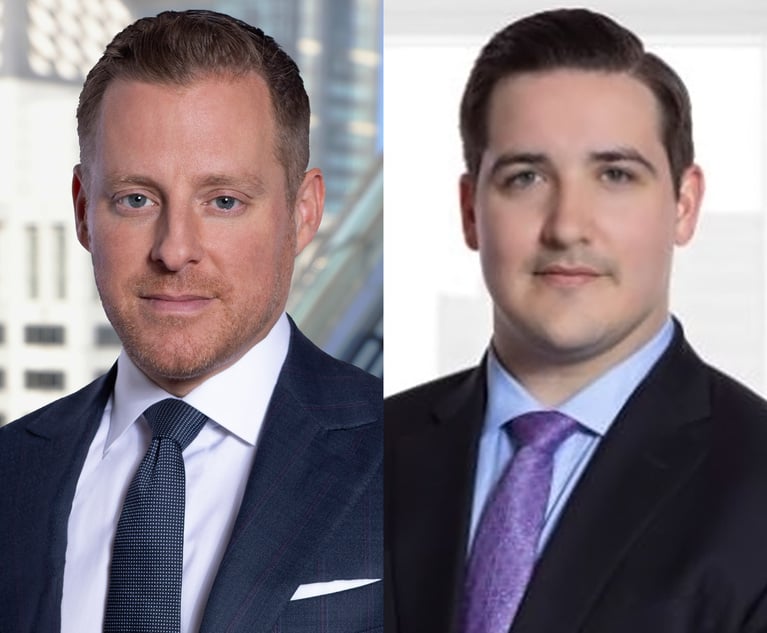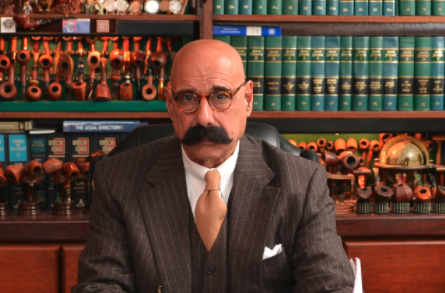Fatal Cardiac Arrest Would Have Occurred Despite Care: Doctor
On Oct. 4, 2011, plaintiffs decedent William Spoonhoward, 62, a warehouse worker, died from cardiac arrest while hospitalized at UPMC Presbyterian, in Pittsburgh.
September 20, 2018 at 03:16 PM
7 minute read
Spoonhoward v. UPMC McKeesport
Defense Verdict
Date of Verdict: May 18.
Court and Case No.: C.P. Allegheny No. GD-13-018178.
Judge: Alan D. Hertzberg.
Type of Action: Medical malpractice, wrongful death.
Injuries: Death.
Plaintiffs Counsel: Victor H. Pribanic; Pribanic & Pribanic, Pittsburgh.
Plaintiffs Experts: R. Matthew Hanak II, economics; Pittsburgh; Dr. Samuel J. Shubrooks Jr., cardiology, Boston.
Defense Counsel: Paula A. Koczan, Weber Gallagher Simpson Stapleton Fires & Newby, Pittsburgh.
Defense Experts: Dr. David L. Fischman, cardiology; Philadelphia; Dr. Louis E. Samuels, cardiac surgery, Philadelphia; Douglas S. King C.P.A., A.B.V., C.F.F.; economics, Pittsburgh.
Comment:
On Oct. 4, 2011, plaintiffs decedent William Spoonhoward, 62, a warehouse worker, died from cardiac arrest while hospitalized at UPMC Presbyterian, in Pittsburgh.
A few days earlier, on Sept. 28, Spoonhoward had presented to UPMC McKeesport hospital with complaints of abdominal pain and a sudden onset of shortness of breath. He was diagnosed with acute coronary syndrome and a stuttering myocardial infarction. Cardiologist Stuart Tauberg made arrangements for an emergent cardiac catheterization. During the procedure, which Tauberg performed, an angiography revealed proximal blockage of a large diagonal artery branch, as well as 70 percent blockage of the left anterior descending artery. Intra-aortic balloon pumps and a guidewire were implanted. During this process, a perforation of the septal branch of the anterior descending artery occurred, which prompted emergency transport of Spoonhoward to UPMC Presbyterian.
At the hospital, an angiography revealed that the perforation was no longer present. Physicians attempted to open the left anterior descending artery but were unsuccessful. Spoonhoward remained hospitalized and was monitored over the ensuing days. On Sept. 30, he had a right heart catheterization to examine blood flow, and he continued to be monitored.
On Oct. 4, an EKG demonstrated sinus tachycardia, which is a faster than normal heart rhythm, and occasional premature ventricular complexes, or extra heartbeats, on the leftward axis. It was noted that the anterolateral myocardial infarction with persistent ST elevation had evolved, when compared to the EKG that had been taken on Oct. 3.
Later that day, a decision was made to remove the intra-aortic balloon pumps. Within a few hours of removal, Spoonhoward suffered respiratory distress and sustained a cardiac arrest. He was later pronounced dead.
Spoonhoward's estate, which was represented by his widow, sued Tauberg, his practice and UPMC McKeesport, alleging negligence amounting to medical malpractice.
UPMC McKeesport was dismissed, prior to trial.
The estate specifically claimed that Tauberg stented the wrong artery and also caused an arterial perforation.
The estate's expert in cardiology testified that Tauberg had improperly placed cardiac stents in the septal branch of the left anterior descending artery, and not in the left anterior descending artery itself, where the blockages were located. The expert noted that Tauberg subsequently advanced a guidewire with a balloon beyond the previously placed stents, which caused the septal branch to perforate when the balloon was inflated.
According to the expert, Tauberg never attempted to open the occluded left anterior descending artery that was responsible for the large myocardial infarction which was occurring. Tauberg believed the septal branch to be the left anterior descending artery, and all of his inflations and stenting were in the septal branch, the expert testified.
Tauberg's counsel argued that he had properly treated Spoonhoward. Tauberg testified that he believed that he appropriately placed the wire in to the left anterior descending artery and then placed several stents without achieving complete recanalization of the coronary artery. At one point, he recognized a perforation of the vessel and decided to transfer the patient to another hospital for continuation of care. Throughout the procedure and following the recognition of this complication, Spoonhoward remained hemodynamically stable, Tauberg testified.
The defense's expert in cardiology noted the complexity of the patient's coronary anatomy and the difficulties encountered during these procedures. According to the expert, the physicians at UPMC Presbyterian attempted to reopen the same vessel, which they also presumed to be the left anterior descending coronary artery. It was only after they re-established the perforation following a repeat balloon angioplasty that they realized the vessel they were attempting to treat was a septal perforator, not the left anterior descending coronary artery, the expert noted.
This procedure was aborted and a decision was made to treat the patient medically. The expert testified that Spoonhoward was deemed not to be a surgical candidate, as the myocardial infarct was at least 24 hours old, and that revascularization would not change his outcome. In addition, due to his many comorbidities, Spoonhoward was not a candidate for heart transplantation or placement of a left ventricular assist device. The expert concluded that Tauberg met the standard of care in his treatment of Spoonhoward.
Spoonhoward is survived by a wife and son. His wife testified about their times together and how they enjoyed going dancing.
The estate sought to recover damages under the Wrongful Death and Survival Acts. The estate's economics expert determined damages of $100,066 in lost earnings, $62,525 in past lost household services, $230,650 in future lost household services and $180,833 in future lost Social Security retirement benefits, for a total of $574,074.
The defense's expert in cardiac surgery opined that Spoonhoward died of the myocardial infarction that he had presented to UPMC McKeesport on Sept. 28, and that no efforts by physicians were going to change that. The expert noted that two experienced cardiac surgeons—Tauberg and the cardiac surgeon at UPMC Presbyterian—attempted to reopen the left anterior descending artery, and were not successful. The expert opined that Spoonhoward's left anterior descending artery was chronically diseased and had progressed to complete occlusion. The expert concluded that, even if the left anterior descending artery could have been opened, the heart damage was already done, and the outcome would have been, more likely than not, less than five years. The defense noted that Spoonhoward had been a longtime smoker and had multiple comorbidities, including cardiomyopathy, hypertension, hyperlipidemia, obesity, diabetes and chronic obstructive pulmonary disease.
According to the defense's expert in cardiology, irrespective of the inability to open the infarct vessel, Spoonhoward's short- and long-term mortality was extremely high. By clinical history and echocardiography, Spoonhoward's infarct, more than likely, started several days prior to his presentation to UPMC McKeesport. He had several days of abdominal and shoulder pain for which he did not seek immediate medical attention, the expert noted. It was only after he developed sudden onset of shortness of breath that he presented to the emergency room.
According to the expert, the echocardiogram performed prior to the emergent cardiac catheterization revealed such abnormalities as anteroseptal and anteroapical akinesis, or a lack of motion in certain areas of the heart, which suggests that the infarct was completed.
The jury rendered a defense verdict. It found that Tauberg was not liable for Spoonhoward's
This report is based on information that was provided by plaintiffs and defense counsel.
—This report first appeared in VerdictSearch, an ALM publication.
This content has been archived. It is available through our partners, LexisNexis® and Bloomberg Law.
To view this content, please continue to their sites.
Not a Lexis Subscriber?
Subscribe Now
Not a Bloomberg Law Subscriber?
Subscribe Now
NOT FOR REPRINT
© 2025 ALM Global, LLC, All Rights Reserved. Request academic re-use from www.copyright.com. All other uses, submit a request to [email protected]. For more information visit Asset & Logo Licensing.
You Might Like
View All
Phila. Jury Awards $15M to Woman Who Slipped on Apartment Building Stairs
4 minute read
Phila. Anesthesiologist Wins Defense Verdict in Multimillion-Dollar Case Over C-Section Complications
3 minute read
Trending Stories
- 1Winston & Strawn Snags Sidley Austin Cross-Border Transactions Partner in Miami
- 2U.S. Attorney Markenzy Lapointe Stepped Down
- 3Slideshow: Judges Who've Retired But Didn't Step Down
- 4Husch Blackwell Hires Former Adobe Counsel to Oversee AI Advisory Offering
- 5CFPB Finalizes Rule Removing Medical Debt From Credit Reports
Who Got The Work
Michael G. Bongiorno, Andrew Scott Dulberg and Elizabeth E. Driscoll from Wilmer Cutler Pickering Hale and Dorr have stepped in to represent Symbotic Inc., an A.I.-enabled technology platform that focuses on increasing supply chain efficiency, and other defendants in a pending shareholder derivative lawsuit. The case, filed Oct. 2 in Massachusetts District Court by the Brown Law Firm on behalf of Stephen Austen, accuses certain officers and directors of misleading investors in regard to Symbotic's potential for margin growth by failing to disclose that the company was not equipped to timely deploy its systems or manage expenses through project delays. The case, assigned to U.S. District Judge Nathaniel M. Gorton, is 1:24-cv-12522, Austen v. Cohen et al.
Who Got The Work
Edmund Polubinski and Marie Killmond of Davis Polk & Wardwell have entered appearances for data platform software development company MongoDB and other defendants in a pending shareholder derivative lawsuit. The action, filed Oct. 7 in New York Southern District Court by the Brown Law Firm, accuses the company's directors and/or officers of falsely expressing confidence in the company’s restructuring of its sales incentive plan and downplaying the severity of decreases in its upfront commitments. The case is 1:24-cv-07594, Roy v. Ittycheria et al.
Who Got The Work
Amy O. Bruchs and Kurt F. Ellison of Michael Best & Friedrich have entered appearances for Epic Systems Corp. in a pending employment discrimination lawsuit. The suit was filed Sept. 7 in Wisconsin Western District Court by Levine Eisberner LLC and Siri & Glimstad on behalf of a project manager who claims that he was wrongfully terminated after applying for a religious exemption to the defendant's COVID-19 vaccine mandate. The case, assigned to U.S. Magistrate Judge Anita Marie Boor, is 3:24-cv-00630, Secker, Nathan v. Epic Systems Corporation.
Who Got The Work
David X. Sullivan, Thomas J. Finn and Gregory A. Hall from McCarter & English have entered appearances for Sunrun Installation Services in a pending civil rights lawsuit. The complaint was filed Sept. 4 in Connecticut District Court by attorney Robert M. Berke on behalf of former employee George Edward Steins, who was arrested and charged with employing an unregistered home improvement salesperson. The complaint alleges that had Sunrun informed the Connecticut Department of Consumer Protection that the plaintiff's employment had ended in 2017 and that he no longer held Sunrun's home improvement contractor license, he would not have been hit with charges, which were dismissed in May 2024. The case, assigned to U.S. District Judge Jeffrey A. Meyer, is 3:24-cv-01423, Steins v. Sunrun, Inc. et al.
Who Got The Work
Greenberg Traurig shareholder Joshua L. Raskin has entered an appearance for boohoo.com UK Ltd. in a pending patent infringement lawsuit. The suit, filed Sept. 3 in Texas Eastern District Court by Rozier Hardt McDonough on behalf of Alto Dynamics, asserts five patents related to an online shopping platform. The case, assigned to U.S. District Judge Rodney Gilstrap, is 2:24-cv-00719, Alto Dynamics, LLC v. boohoo.com UK Limited.
Featured Firms
Law Offices of Gary Martin Hays & Associates, P.C.
(470) 294-1674
Law Offices of Mark E. Salomone
(857) 444-6468
Smith & Hassler
(713) 739-1250







